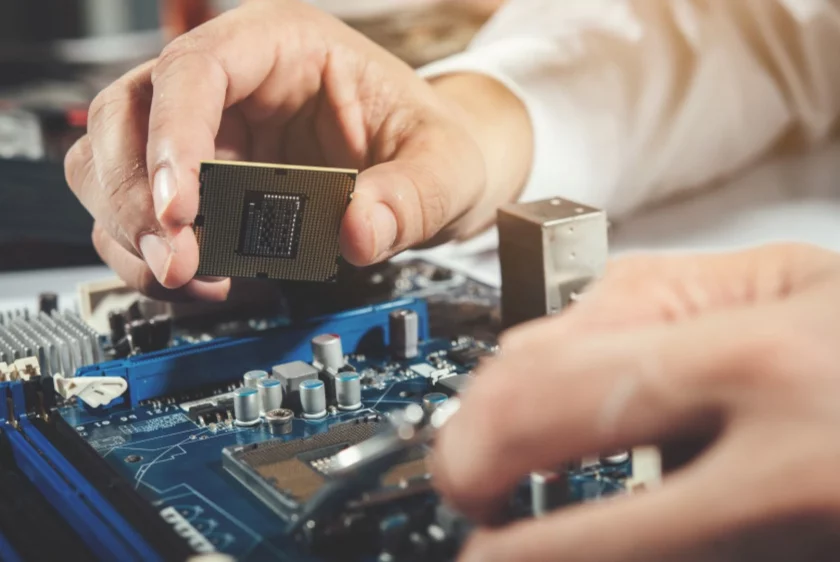Printed circuit boards (PCBs) are the functional core of any electronic system, from small sensors to complex industrial modules. But a PCB itself is vulnerable. Moisture, vibration, dust or chemical contaminants can cause electrical failures, short circuits, deterioration of solder joints or even total destruction of the device.
When equipment must operate in demanding environments – automotive, defense, heavy industry, e-mobility – physical protection of electronic boards becomes essential.
In this article, we explore how encapsulants and technical fillers can protect PCBs, the differences between epoxy and polyurethane (PU), and how to choose the most suitable material depending on the application.
Why protect a PCB?
Unlike laboratory environments, real electronic systems are exposed to multiple risk factors that can compromise their performance:
- Ambient humidity or condensation can cause short circuits and accelerate corrosion of tracks and metal contacts.
- The presence of chemical contaminants or fine dust can affect electrical performance, interfere with signals and reduce insulation resistance.
- Constant mechanical vibrations or repeated impacts can cause micro-cracks in welds, component disconnection or material fatigue.
- Abrupt thermal variations or high temperature environments generate expansion and contraction that stress the bonds and the structural integrity of the PCB.
Encapsulation with suitable materials is an effective solution to mitigate all these risks and ensure stable and long-lasting product performance.
What is PCB encapsulation?
Potting consists of applying a liquid material on the printed circuit board which, once cured, forms a solid or semi-rigid protective layer. This material can cover the entire PCB(potting) or only certain sensitive areas(coating), depending on the level of protection required.
The materials most commonly used in electronic encapsulation are epoxies and polyurethanes (PU). Both have very different properties in terms of stiffness, flexibility, chemical resistance and thermal behavior, which allows them to be adapted to the specific needs of each application.
At Cyclops Synergies we offer encapsulant solutions formulated for demanding industrial environments, and we work with customers in sectors such as automotive, aerospace, medical electronics, lighting and consumer electronics.
Epoxy encapsulants: maximum stiffness and chemical resistance
Epoxy encapsulants are thermosetting resins that, once cured, form a solid and rigid structure. They are especially indicated when needed:
- High resistance to aggressive chemicals, oils, fuels or solvents present in industrial environments.
- Excellent electrical insulation, guaranteeing protection against shunts, leakage or interference.
- Long-term thermal stability, withstanding high temperatures without degradation or change in properties.
- High structural mechanical strength, ideal for protecting electronics from impact, compression or intensive handling.
Epoxies are the most suitable solution for applications in sectors such as industrial instrumentation, rugged sensors, aerospace equipment or power electronics. Their main limitation is their stiffness, which can be a disadvantage in environments subject to vibration or continuous movement.
Polyurethane encapsulants: flexibility and vibration absorption
Polyurethane (PU) is a more flexible option, with an elastic behavior that makes it ideal for absorbing vibrations, mechanical shocks and repeated thermal shocks. Its main advantages include:
- High mechanical stress absorption capacity, reducing stress on solder joints and fragile electronic components.
- Good resistance to humidity, with protection capacity in humid environments or with risk of intermittent condensation.
- Wide working temperature range, which allows its use in outdoor applications or applications exposed to intense thermal cycles.
- Fast or low-temperature curing versions are available, facilitating integration into automated processes.
PU encapsulants are widely used in automotive on-board electronics, LED lighting devices, mobile sensors, portable measuring equipment and systems exposed to constant motion.
Which solution to choose?
The choice of encapsulant should be based on a technical analysis of the application. Some fundamental criteria are:
- The environment of use: indoor, outdoor, industrial, automotive, chemical, etc.
- The thermal sensitivity of the components, or the need for cold curing to avoid damage.
- The desired stiffness or flexibility, depending on the type of use (static or dynamic).
- Industry regulatory requirements such as UL94, REACH, RoHS, etc.
- Assembly and production conditions, including curing times, automation, process compatibility and space availability.
At Cyclops Synergies we accompany our clients in this analysis, and propose the most appropriate solution not only from a technical point of view, but also in terms of process feasibility and economic efficiency.
Consult our PCB protection solutions o contact us directly. We are here to help you.






